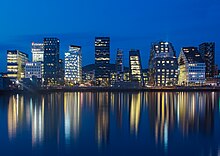
Back اقتصاد النرويج Arabic Economía de Noruega AST Norveç iqtisadiyyatı Azerbaijani Икономика на Норвегия Bulgarian Economia de Noruega Catalan Ekonomika Norska Czech Norges økonomi Danish Wirtschaft Norwegens German Οικονομία της Νορβηγίας Greek Economía de Noruega Spanish
 | |
| Calendar year | |
Trade organisations | EFTA, OECD, WTO, EEA and others |
Country group | |
| Statistics | |
| Population | |
| GDP | |
| GDP rank | |
GDP growth | |
GDP per capita | |
GDP per capita rank | |
GDP by sector |
|
| 4.5% (Feb. 2024 est.)[7][8] | |
Population below poverty line | |
Labour force | |
Labour force by occupation |
|
| Unemployment | |
Average gross salary | €55,200 annual |
| €40,500 annual | |
Main industries | |
| External | |
| Exports | |
Export goods | petroleum and petroleum products, machinery and equipment, metals, chemicals, ships, fish |
Main export partners |
|
| Imports | |
Import goods | machinery and equipment, chemicals, metals, foodstuffs |
Main import partners |
|
FDI stock | |
Gross external debt |
|
| Public finances | |
| +4.4% (of GDP) (2017 est.)[6] | |
| Revenues | 217.1 billion (2017 est.)[6] |
| Expenses | 199.5 billion (2017 est.)[6] |
| Economic aid | $4.0 billion (donor), 1.1% of GDP (2017) [1] |


The economy of Norway is a highly developed mixed economy with state-ownership in strategic areas. Although sensitive to global business cycles, the economy of Norway has shown robust growth since the start of the industrial era. The country has a very high standard of living compared with other European countries. Norway's modern manufacturing and welfare system rely on a financial reserve produced by exploitation of natural resources, particularly North Sea oil.[21][22][23][24][25] Among OECD nations, Norway has a highly efficient and strong social security system; social expenditure stood at roughly 22.6% of GDP.[26][27][28]
- ^ "World Economic Outlook Database, April 2019". IMF.org. International Monetary Fund. Retrieved 29 September 2019.
- ^ "World Bank Country and Lending Groups". datahelpdesk.worldbank.org. World Bank. Retrieved 29 September 2019.
- ^ "Population on 1 January". ec.europa.eu/eurostat. Eurostat. Retrieved 13 July 2020.
- ^ a b c d "Report for Selected Countries and Subjects: April 2023". imf.org. International Monetary Fund.
- ^ a b c "The outlook is uncertain again amid financial sector turmoil, high inflation, ongoing effects of Russia's invasion of Ukraine, and three years of COVID". International Monetary Fund. 11 April 2023.
- ^ a b c d e f g h i j k l m n "The World Factbook". CIA.gov. Central Intelligence Agency. Retrieved 29 June 2019.
- ^ https://www.ssb.no/priser-og-prisindekser/konsumpriser/statistikk/konsumprisindeksen
- ^ "World Economic Outlook Database, April 2020". IMF.org. International Monetary Fund. Retrieved 15 April 2020.
- ^ "People at risk of poverty or social exclusion". ec.europa.eu/eurostat. Eurostat. Retrieved 13 January 2020.
- ^ "Gini coefficient of equivalised disposable income – EU-SILC survey". ec.europa.eu/eurostat. Eurostat. Retrieved 3 October 2019.
- ^ "Human Development Index (HDI)". hdr.undp.org. HDRO (Human Development Report Office) United Nations Development Programme. Retrieved 11 October 2022.
- ^ "Inequality-adjusted HDI (IHDI)". hdr.undp.org. UNDP. Retrieved 11 October 2022.
- ^ a b c "Labor Force Survey". ssb.no. Statistics Norway. Retrieved 29 September 2020.
- ^ https://www.ssb.no/arbeid-og-lonn/sysselsetting/artikler/arbeidsledighet-i-norge
- ^ "Unemployment rate by age group". data.oecd.org. OECD. Retrieved 8 September 2020.
- ^ SSB, https://www.ssb.no/utenriksokonomi/utenrikshandel/statistikk/utenrikshandel-med-varer/artikler/norges-viktigste-handelspartnere, 2023
- ^ SSB, https://www.ssb.no/utenriksokonomi/utenrikshandel/statistikk/utenrikshandel-med-varer/artikler/norges-viktigste-handelspartnere, 2023
- ^ "Sovereigns rating list". Standard & Poor's. Archived from the original on 28 September 2011. Retrieved 26 May 2011.
- ^ a b c Rogers, Simon; Sedghi, Ami (15 April 2011). "How Fitch, Moody's and S&P rate each country's credit rating". The Guardian. Archived from the original on 1 August 2013. Retrieved 31 May 2011.
- ^ "Scope affirms Norway's AAA rating with Stable Outlook". Scope Ratings. Retrieved 30 September 2023.
- ^ The economic effects of north sea oil on the manufacturing sector Archived 2 February 2014 at the Wayback Machine Hilde Christiane Bjørnland
- ^ Overview of the Norwegian oil and gas sector Archived 23 May 2013 at the Wayback Machine Embassy of Denmark, Oslo
- ^ "Archived copy" (PDF). Archived from the original (PDF) on 20 June 2013. Retrieved 28 December 2012.
{{cite web}}: CS1 maint: archived copy as title (link) - ^ The Oil Industry and Government Strategy in the North Sea Øystein Noreng
- ^ "The rich cousin". The Economist. 1 February 2013. Archived from the original on 1 February 2013. Retrieved 1 February 2013.
- ^ Kenworthy, Lane (1999). "Do Social-Welfare Policies Reduce Poverty? A Cross-National Assessment" (PDF). Social Forces. 77 (3): 1119–1139. doi:10.2307/3005973. JSTOR 3005973. Archived (PDF) from the original on 10 August 2013.
- ^ Moller, Stephanie; Huber, Evelyne; Stephens, John D.; Bradley, David; Nielsen, François (2003). "Determinants of Relative Poverty in Advanced Capitalist Democracies". American Sociological Review. 68 (1): 22–51. doi:10.2307/3088901. JSTOR 3088901.
- ^ "Social Expenditure – Aggregated data". Organisation for Economic Co-operation and Development.
Cite error: There are <ref group=note> tags on this page, but the references will not show without a {{reflist|group=note}} template (see the help page).
© MMXXIII Rich X Search. We shall prevail. All rights reserved. Rich X Search